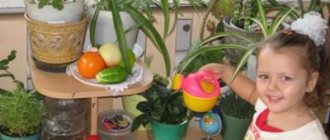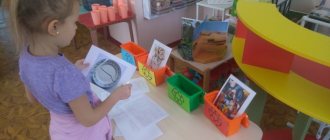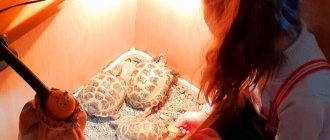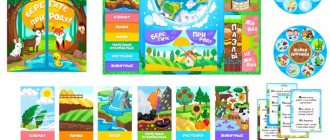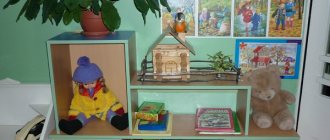Lesson to familiarize middle group children with nature “Duty in a corner of nature”
Lesson to familiarize middle group children with nature “Duty in a corner of nature”
Objectives: — Strengthen the knowledge and skills of children
on caring for plants
in a corner of nature
.
— To develop responsibility for the assigned task and the ability to bring it to the end. Foster love and interest in plants, a desire to care for them, and create favorable conditions for their growth.
— Develop interest, hard work, curiosity
, the desire to care for plants
in a corner of nature
.
Target:
Show children the features of being on duty in a corner of nature
.
Instill interest and develop curiosity
.
Create responsibility for caring for plants.
Equipment: Rags, sticks, watering can, scissors, spray bottle.
GCD move
Educator: Guys, the sun came to our lesson. What is it like?
Children: Cheerful, radiant, yellow, spring
Educator: Let's smile at each other like the sun to us, let's give each other a good mood.
-And now I will read you a poem. Can you tell me what it's about?
Poem “Flowers give us inspiration”
Flowers give us mood,
And awaken inspiration
As a symbol of pure beauty,
It’s very difficult without a dream!
Children: About flowers
Educator: That's right, children, this is a poem about flowers. And in today's lesson we will learn to be on duty in a corner of nature
.
Guys, do you want to learn how to be on duty in a corner of nature?
?
Children: Yes
Educator: How do we care for plants?
Children: Water, loosen the soil, cut off dry leaves, spray.
Educator: How do you know that the soil is dry?
Children: it becomes hard and cracks.
Educator: This is why we have to water the flowers so that they don’t wilt.
Guys, you need to water the plants carefully, the spout of the watering can should touch the pot.
(the teacher shows how to water a flower correctly)
-……. please show me how to water a flower correctly.
Look, guys, how to properly water the plants……… the spout of the watering can touches the edge of the pot.
Educator: Why do you need a spray bottle, scissors, sticks, a rag? Let's think about it.
Does anyone know what is in my hands? Pulvezer.
-What do you think a spray gun is for?
Arslan: A spray gun is needed to spray flowers.
Educator: Correct! You need to spray so that the leaves on the flower take in additional moisture.
Now we will try to spray the flower. (The teacher shows how to spray a flower correctly, then the child sprays it himself.)
Educator: Veronica, why do we need scissors?
Veronica: Scissors are needed to cut dry leaves.
Educator: That's right, but why do we need sticks, David will answer us.
David: A stick is needed to loosen the ground.
Educator: That's right, you need to loosen the soil so that the roots of the flower can breathe. But you need to loosen carefully closer to the edge of the pot so as not to damage the roots. (the teacher shows how to loosen the soil)
-Please.........show me how to properly loosen the soil.
Well done, you did everything right.
Educator:…….., why do you think we need a rag?
Julia: A rag is needed to wipe the leaves.
Educator: That's right, you need to wipe it very carefully so as not to damage the leaves (the teacher shows how to wipe the leaves)
Julia, now please show me how to properly wipe the leaves of a flower.
Educator: Well done.
Educator: Indoor plants need different care: Some love the sun, for example geranium, and violet loves the shade.
Phys. just a minute
The flower was sleeping and suddenly woke up. (torso to the right and left)
I didn't want to sleep anymore. (torso forward and backward)
He moved and stretched. (hands up, stretch)
He soared up and flew. (hands up, right, left)
The sun will just wake up in the morning
The butterfly circles and swirls (spin)
Educator: Children, what did we do today? What they were doing?
Children's answers
:
Flowers were watered.
Loosened the soil in pots
They sprayed the flowers and wiped the leaves.
Learned to be on duty in a corner of nature
.
Educator: That's right, guys. Plants are living, just like us. They eat, breathe, drink water. They need sunlight, without it the plants are frail, lethargic and pale.
And only in good conditions do plants not turn pale, do not wither and make us happy. Then it’s nice to look at them and admire them.
Program content.To clarify and consolidate children’s knowledge about plant care techniques and the sequence of work. Clarify knowledge about equipment for work and where it is stored. Explain the structure of the duty board. To develop responsibility for the assigned task and the ability to complete it.
Progress of the lesson.
The children are sitting in their places. The teacher, turning to them, says: “Children, today we will talk about how we care for plants, what we do (children list).” Then he asks questions: “How do you know when a plant needs to be watered? (The earth is dry to the touch, light.) What kind of water do we water? (Warm water that has been sitting in watering cans since yesterday.) How should you water correctly? (Invites one of the children to show how to water.) Did Vova water the plant correctly? That's right, he holds the spout of the watering can right above the pot, watering it carefully and accurately. What do we do first, water or wipe the pot, saucer and windowsill? Why do you need to water first? (Then you can spray it on the saucer and window sill, and you will have to wipe it again. The child shows how to wipe the pot.) When all the plants are watered, what else needs to be done? (Pour water into the watering cans and leave them for tomorrow so that the water warms up.) What else is needed to care for plants, besides watering cans? (Rags, bowls, oilcloths.) What should be done with them after the work is finished? (Wipe oilcloths, rinse and dry rags.) Where is everything needed to care for plants stored? (In the table under the aquarium, everything is in its place.)
Since the very form of organizing work turns out to be difficult for children at first (they forget that they are on duty, are distracted, do not finish the job, etc.), the teacher does not initially show them new techniques for caring for plants. They are introduced gradually as the children get used to being on duty. Much attention is paid to organizing duty, especially at first. To develop the habit of being on duty in children, the teacher uses different techniques: reminds some children that they forgot to water the plants or put away their equipment, gives others examples of comrades who are doing their duties well, asks others if they have done everything, and offers to go back and see if this is so, etc. But you cannot focus children only on performing plant care techniques; You should definitely draw their attention to the changes occurring in the plants and encourage those children who have seen more.
In order to give children more time to observe plants while on duty, it is advisable to organize duty in the older group for 2-3 days, but only in the first half of the day, so that the children do not get tired. In the afternoon it is better to use individual orders. Being on duty does not preclude the use of assignments. If there are many plants in a group, not all of them can be served by the person on duty; Some are looked after by children who have received individual assignments—work assignments. These assignments can be sporadic or longer, lasting several days.
From time to time, also in the second half of the day, the teacher gathers those on duty, talks with them about how they perform their duties, what they do and how, what new things they noticed in the plants.
When the children get used to being on duty, the teacher introduces them to new types of plant care: spraying, pruning dry leaves, then loosening the soil; teaches new care techniques. It is better to do this at the end of a lesson on familiarization with indoor plants, and the meaning of each technique should be explained and the children should be provided with the necessary equipment to complete the work. The teacher teaches children how to loosen the soil on plants that have a sufficiently deep root system (so that the children do not damage it).
In the older group, complications are introduced into the types of care already known to children: the teacher draws attention to the fact that in autumn and winter plants hardly grow, many do not bloom, so they need to be watered less often. With the onset of spring, children see that the plants begin to grow, young leaves and buds appear on them. The teacher leads the children to the conclusion that at this time the plants are watered more often. At the end of March - beginning of April, when plant life awakens, they begin to fertilize.
|
Children's work in a corner of nature in middle groups
In the middle group, children are more independent. They acquired some knowledge and skills in caring for plants and animals in a corner of nature. Now they can carry out daily tasks under supervision: water the plants, feed the fish, birds, pick fresh grass for the rabbit, etc. Now the task is to continue to develop in children an interest and love for nature, to teach them to take care of animals and plants.
Indoor plants are permanent inhabitants of the corner of nature in all kindergarten groups. This makes it possible to teach children how to care for plants.
Plant care at the beginning of the year is carried out in the presence of children. Gradually inviting them to help as much as possible, showing them how to pour water, how to hold a watering can, watering, wiping leaves, naming care items, teaching children to put everything in its place.
First, under supervision, and then independently, children carry out tasks for caring for plants: wiping large leaves, watering. In the middle of winter, it is already possible to wash indoor plants together with small subgroups of children.
Two or three children are assigned to wipe the plants, the rest to play, explaining that next time others will do this work. Pots with plants are placed on benches or on the floor if the plants are tall.
At the beginning, it is suggested to look at how to wipe the leaves, showing how to run the cloth over the leaf in one direction from the petiole to the end, otherwise the leaf may break. Then the children roll up their sleeves to avoid getting them dirty. Everyone is invited to wet a cloth in a basin, wring it out, place the sheet on the palm of the left hand, and if the sheet is large, place the sheet over the entire arm, up to the elbow, and wipe carefully. While working, each child must be observed. Two or three children can be assigned to wash the trays in another basin of warm water.
After work, wipe the floor, rinse the rags, wring them out and hang them to dry, then put the plants back in place.
When examining the plants after work, you need to ask the children: “What did the plants look like after they were washed?” Bring children to the conclusion: plants need care, then they will grow and develop better.
Children continue to get acquainted with fish, birds, and small animals of this corner of nature.
A child of the fifth year of life can help in caring for birds: wash the drinking bowl, pour water, pour out food. Place the drinking bowl and feeder in a specific place. In the process of this work, children watch how birds peck, how they drink, bathe, splashing water, and place delicacy-seedlings of oats in a pot that they themselves grew for them.
The child’s participation in caring for birds helps to develop a caring attitude towards living beings, the ability to carefully observe and recognize them (small birds often seem very similar even to adults).
In a corner of nature of the middle group, you can keep a guinea pig or a rabbit (if the appropriate conditions exist). Now observations of these animals can be not only short-term during classes, but also while caring for them. (A rabbit cannot be kept in a group room.)
It should be remembered that the example of adults is the main condition for instilling in children an interest and respect for nature.
During the winter, children sow oats for rabbits and birds (they need green food), just like kids plant onions, monitor their growth, and carefully water them (without flooding the bulbs).
In spring, the corner, and the entire group room, is decorated with the first spring flowers: coltsfoot, blue and white coppice, dream grass, corydalis, goose onion, etc.
In summer, children bring plants from fields, meadows and forests to the corner of nature.
The nature corner in the senior group is distinguished by a wide variety of plants and animals. The organization of work and observations here is also different, since children already have ideas about plants and animals and the skills to care for them. Therefore, care for objects in the corner of nature is carried out by those on duty under the guidance of a teacher.
In this group, a large place is occupied by children's long-term observations of the growth and development of plants and animals. Systematic and properly organized educational work with children in a corner of nature plays a big role in this.
As in all kindergarten groups, indoor plants are permanent and obligatory plants in the corner of nature.
Plant care in the corner of nature is carried out by those on duty under the guidance of a teacher (duties are organized at the beginning of the year). They water the plants. Watering plants is a difficult type of care for children. Being carried away by the process of watering, they can water the same plant several times a day. Therefore, this work is performed by children under the supervision of a teacher. Involving all the children in turn in watering, it is necessary to teach each child how to hold the watering can correctly (by placing its spout to the edge of the pot), to teach them to pour water little by little, slowly, to pour water until all the soil in the pot is wet and no water will appear on the tray.
When caring for bulbous plants, water only the ground and under no circumstances overwater the bulb. It is necessary to explain to the children that they need to water the plants with the water that was already in the room. It is also necessary to remember that plant leaves must be kept clean and washed with warm water: cold water is harmful to them. Plants with small leaves (for example, tradescantia, evergreen begonia) are watered from a watering can with a strainer, placing the plants in a basin.
It is necessary to show how to loosen the soil in pots with a stick, gradually accustoming children to this care.
During the spring-summer period, when plants need more nutrition, it is necessary to feed the plants with organic or mineral fertilizers in the presence of children, involving children in the work (water the plants before and after feeding), explaining to them the purpose of feeding.
